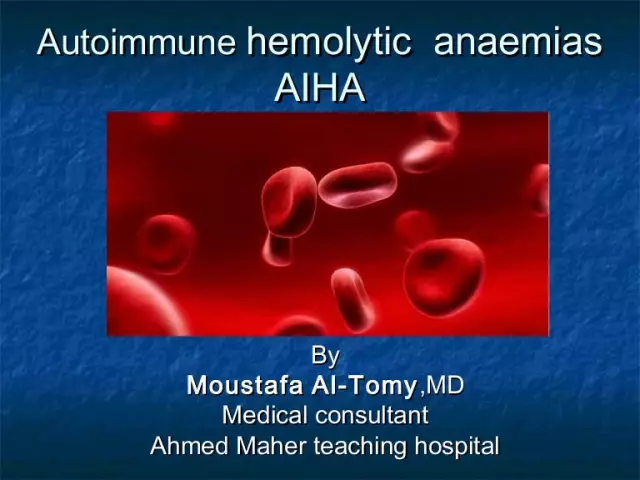- Author Rachel Wainwright [email protected].
- Public 2023-12-15 07:39.
- Last modified 2025-11-02 20:14.
Autoimmune hemolytic anemia

Hemolytic anemias are a combination of both congenital and acquired diseases, which are characterized by the destruction of red blood cells within cells or within blood vessels. Autoimmune hemolytic anemias (abbreviated as AGA) are the most common type of hemolytic anemia.
Autoimmune hemolytic anemia: etiology, pathogenesis, classification and clinical picture
Hemolytic anemia can develop as a result of a conflict of blood type or Rh factor between the mother and the fetus, or as a result of donor blood transfusion. They are called isoimmune.
The second group includes cases when the own immune system produces antibodies to its own erythrocytes. They are called autoimmune hemolytic anemias. When conducting a diagnostic blood test in patients with AGA, IgG immunoglobulins (rarely IgM and IgA) show a deviation from the norm.
In most cases, autoimmune hemolytic anemias occur in the form of various specific and nonspecific symptoms against the background of other blood diseases; can proceed both in acute form and in the form of a chronic process.
In acute cases, the disease begins with weakness, shortness of breath and palpitations, fever, vomiting and jaundice, pain in the heart and lower back.
Chronic autoimmune hemolytic anemia is often almost asymptomatic with periodic exacerbations. Against the background of remission, there is an increase in the liver and spleen on palpation, often jaundice.
In a detailed analysis of blood in patients with AHA, in particular, normal or increased hemoglobin, an increase in ESR, and a normal level of platelets are noted. In the acute form and with exacerbations of the chronic course, the number of leukocytes increases, while in the stage of remission their level is normal.
The diagnosis of "autoimmune hemolytic anemia" is most often more accurately differentiated by specialists after specific diagnostic studies.
Treatment options for autoimmune hemolytic anemias

The tactics of treating autoimmune hemolytic anemia in the acute course of the disease or exacerbation of the chronic process necessarily includes hormone therapy. The average daily dose of prednisone 60-80 mg is divided into three doses in a ratio of 3: 2: 1. In case of ineffectiveness of treatment, it can be increased to 150 mg and above, and as the patient's condition improves, it gradually decreases (by 2.5-5 mg per day in order to avoid relapses), first to half of the initial dosage and then until the drug is completely discontinued …
In the chronic course of the disease, the treatment of autoimmune hemolytic anemia requires the appointment of prednisolone, but in a daily dose of 20-25 mg. The drug is taken under laboratory control, and as the blood counts normalize, its dose gradually decreases to a maintenance dose of 5-10 mg per day.
Sometimes the prescription of drugs from the group of immunosuppressants is also advisable and justified in the therapy of AGA, and in severe hemolytic crises, infusion therapy is indicated: individually selected erythrocyte mass, hemodesis, etc. for intoxication. Sometimes blood plasma, washed or frozen erythrocytes are transfused, hemodialysis (artificial kidney) and prasmopheresis (removal of the liquid part of the blood - plasma - along with antibodies) are used.
A number of patients with AGA are characterized by increased resistance to the action of hormonal drugs. The course of the disease is characterized by frequent relapses and practically does not lend itself to medical correction. For the treatment of AGA in this category of patients, radical treatment is used - splenectomy (removal of the spleen), which significantly improves the quality of life.
Despite the highest level of development of modern medicine, the treatment of hemolytic anemias is very difficult, and the diagnosis is often unfavorable.
The information is generalized and provided for informational purposes only. At the first sign of illness, see your doctor. Self-medication is hazardous to health!


